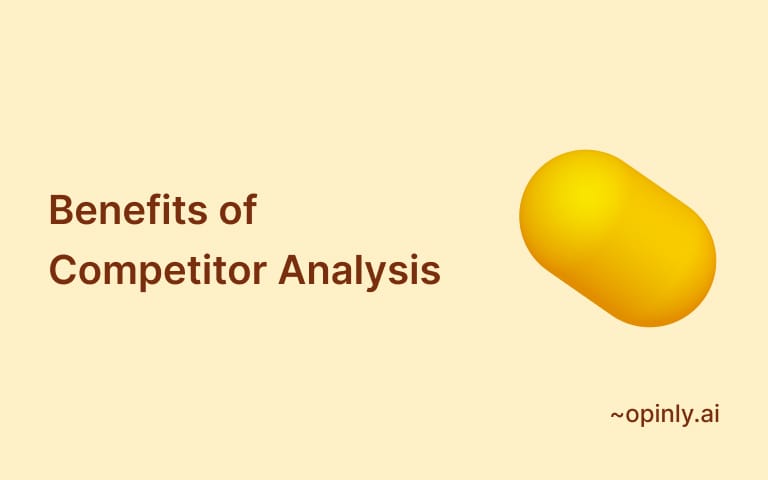Benefits of Competitor Analysis Tools for Your Business
Maximize your SEO strategy with the best competitor analysis tools in the market. Stay ahead by identifying keyword gaps and outdoing your rivals with Opinly AI.

Importance of Competitor Analysis in Today's Business Environment
In today's marketing business, business owners and marketers continuously check edges over their competitors.
Competitor analysis has emerged as an important strategic tool that helps organizations to remain competitive.
By understanding their competitors' strategies, strengths, and weaknesses, businesses can create strategies that counteract their competitors' moves and discover new market opportunities.
In this article, let us discover the benefits of competitor analysis for your business.
The Strategic Necessity of Competitive Analysis Tool

Competitor analysis is not just about keeping tabs on rivals; it's a proactive strategy to anticipate changes in the market and respond innovatively.
In sectors where technology and consumer preferences evolve swiftly, being aware of competitors’ actions can make the difference between leading the market or falling behind.
This competitive analysis helps businesses to:
- Predict Market Trends: By observing competitors, companies can forecast changes in consumer preferences and technology advancements, allowing them to proactively adjust their product offerings and marketing strategies.
- Benchmarking Performance: It allows businesses to measure their operations, products, and services against those of their competitors, identifying areas for improvement and innovation.
- Risk Mitigation: Understanding competitors’ strategies helps businesses anticipate potential threats and adjust their strategies to mitigate risks.
The Role of Competitor Research Analysis Tools

The role of competitor analysis tools has revolutionized how businesses approach this critical task. These tools provide detailed insights into competitors’ SEO strategies, content marketing, social media presence, and more.
They automate the collection and analysis of vast data, turning it into actionable intelligence that businesses can use to make informed decisions.
- SEO and Online Visibility: Tools like SEMrush and others provide analytics that help businesses understand their search engine ranking competitors, identify keyword opportunities, and analyze backlink profiles.
- Content and Social Media Strategy: By analyzing competitors' content strategies, businesses can identify what types of content are engaging audiences and gaining traction. Tools that track social media performance can also reveal insights into competitors' engagement strategies and campaign effectiveness.
- Pricing and Product Analysis: Some tools help monitor pricing strategies and product changes, allowing businesses to stay competitive by adjusting their offerings in real time.
Understanding Competitor Analysis Tools
Competitor analysis tools are sophisticated software solutions that provide businesses with crucial insights about their rivals.
These tools streamline the process of gathering, analyzing, and interpreting data about competitors' strategies, behaviors, and performance.
They serve a broad scope, helping companies to delve deep into the competitive landscape and emerge with actionable strategies tailored to their unique market conditions.
Definition and Scope of Competitor Website Analysis Tools
Competitor analysis tools are digital platforms or software that help businesses systematically track and evaluate their competitors' activities. These tools cover different aspects of business operations, such as marketing, sales, SEO, and product development.
They gather information in several ways, including scanning public websites and analyzing social media activities, giving a complete view of competitors' market positioning.
These tools do more than just monitor; they help predict future trends, spot emerging patterns, and aid in strategic planning. By combining various pieces of information, businesses can fully understand where they stand in the market compared to their competitors, helping them see potential challenges and opportunities.
Types of Competitor Analysis

Competitor analysis can be categorized into several types, each focusing on different aspects of business strategy:
1. SEO Competitor Analysis
This involves analyzing competitors' search engine optimization strategies to understand better which keywords they are ranking for, the quality of their backlinks, and their overall online visibility.
2. SEM tools for Social Media
Here, the focus is on competitors' paid advertising strategies. Tools like SEMrush can show what keywords competitors are bidding on, the structure of their ad campaigns, and how much they spend.
3. Keyword Content Analytics
This step incorporates keyword research and SEO competitor analysis to enhance content marketing strategies. This examines the types of content competitors produce, their frequency, and the reception of such content by the audience. It includes blog posts, white papers, videos, and more, all of which can benefit from keyword research and SEO strategies to improve digital marketing efforts.
4. Product and Pricing Ranking Analysis
Some tools track changes in competitors’ product offerings, features, and pricing strategies, enabling businesses to adjust their offerings to remain competitive.
Key Features of Competitor Analysis Tools for SEO
An effective competitor analysis tool offers several key features that help in comprehensive competitive research:
- Analytics and Reporting: These provide detailed reports and dashboards that highlight key metrics such as market share, growth rates, and comparative rankings. They help visualize data in an easy-to-understand and actionable way, which is vital for PPC campaigns and SERP improvements.
- Keyword Gap Analysis: This feature helps identify keywords for which competitors are ranking and your business is not. This insight is crucial for optimizing SEO and SEM strategies.
- Backlink Analysis: Understanding who links to your competitors' websites can provide opportunities to enhance your own SEO strategy by targeting similar backlinks.
- Real-time Monitoring: Many tools offer the ability to track competitors' activities in real time, providing alerts whenever a competitor launches a new product, changes a price, or updates their website. This showcases the importance of competitor research and competitive intelligence.
- Integration Capabilities: The best tools integrate with other business systems such as CRM or marketing automation platforms, allowing for seamless data flow and richer insights.
10 Benefits of Using Competitor Analysis Tools

Competitor analysis tools are vital in today's data-driven business environment. They help organizations navigate complex markets and refine their competitive strategies. Below are ten significant benefits of utilizing these tools effectively, including improved SERP rankings and enhanced competitive intelligence.
1. Gaining Actionable Insights to Improve Business Strategy
Competitor analysis tools break down a lot of data to give valuable insights that can greatly impact a business's strategy. These insights reveal what competitors are doing well and where they're lacking, helping businesses adjust their strategies effectively.
This way, companies can make informed decisions, such as redirecting budgets to more successful areas, updating product features, or changing marketing tactics, all based on solid facts and figures.
2. Enhancing Backlink and Keyword Gap through Competitor Website Analysis
Backlinks, or inbound links from other websites to your own, are a cornerstone of SEO. They signal to search engines that other sites find your content valuable enough to link to, which can improve your site's authority and rankings.
However, not all backlinks are created equal. The quality, relevance, and number of backlinks can dramatically affect your website's search engine performance.
Focus on acquiring backlinks from high-authority sites. You can also look for broken links on these sites and offer your content as a replacement.
If competitors get links from guest posts, webinars, or collaborations, consider similar strategies for your site.
3. Identifying Niche Opportunities and Weaknesses in Competitors' Strategies
With deep insights into competitors' actions, businesses can spot niche opportunities that competitors might overlook.
This could include underserved markets, potential for product innovation, or gaps in service offerings. Similarly, by identifying weaknesses in competitors' strategies, businesses can position themselves to exploit these gaps, offering superior alternatives that meet the unaddressed needs of customers.
4. Facilitating Competitor Data Strategy Development
Rather than reacting to market changes, competitor analysis tools allow businesses to anticipate shifts and develop proactive strategies.
This forward-looking approach helps companies to stay ahead of trends and adapt to changes more swiftly than competitors, maintaining a competitive edge in rapidly evolving industries.
5. Streamlining Market Entry for Right Competitor Analysis Tools
Understanding the competitive landscape can significantly reduce risks when launching a new product.
Competitor analysis tools provide insights into market saturation, competitor product features, and prevailing pricing strategies, which can inform more strategic decisions about product design, marketing, and pricing.
6. Optimizing Pricing Strategies
Competitor analysis tools help businesses monitor competitors' real-time pricing changes, which is important for industries where price competitiveness is key.
By understanding how competitors price their products and services, companies can adjust their pricing strategies to attract more customers without sacrificing profit margins.
7. Improving SEO and Online Visibility
Competitor analysis tools often include SEO tracking features that help businesses understand how competitors are achieving high rankings on search engines. By analyzing keywords, backlinks, and content strategies, businesses can refine their SEO efforts to improve their rankings and online visibility.
8. Enhancing Content Marketing Strategies
By analyzing competitors' content, businesses can identify what types of articles, videos, or infographics engage the audience. This allows them to create their content strategies to attract better and retain customers, increasing overall engagement and driving conversions.
9. Monitoring Competitor Innovations and Responses
Competitor analysis tools keep businesses informed about new products, services, or features their competitors introduce and how the market responds to these innovations. This continuous monitoring helps companies stay on top of industry trends and quickly respond to their innovations.
10. Increasing Overall Business Agility
Finally, the comprehensive insights competitor analysis tools provide enhance a business's overall agility. With a clearer grasp of the competitive landscape, businesses can adapt faster, tackling new challenges and grabbing opportunities more effectively than ever.
Case Studies and Success Stories with Opinly AI

Competitor analysis tools have become a cornerstone for businesses aiming to excel in their respective markets by providing deep insights into the competitive landscape.
Below are detailed case studies and success stories highlighting how real-world businesses have effectively used these tools through Opinly AI, demonstrating the substantial impact on their market ranking and overall business performance.
E-Commerce Retailer Enhances Market Share
Background: An e-commerce retailer specializing in consumer electronics struggled to capture a significant market share due to intense competition from established brands.
Challenge: The retailer needed to understand the competitive strategies surrounding pricing, product assortment, and promotional tactics to carve out a niche in the crowded market.
Solution: The retailer analyzed competitors' product offerings, pricing strategies, and customer reviews by utilizing Opinly AI's competitor analysis tools. The tool provided insights into which products were most popular among competitors and identified pricing patterns during different times of the year.
Outcome: Armed with these insights from competitive intelligence tools, the retailer adjusted its product offerings to include trending products not heavily promoted by competitors. They also optimized their pricing strategy to be more competitive during key sales periods. As a result, the retailer saw a 30% increase in market share and a significant improvement in customer acquisition rates.
How to Integrate Opinly AI's Competitor Analysis Software into Your Business
Integrating Opinly AI’s competitor analysis tools into your business operations can significantly enhance strategic planning and execution.
Below is a step-by-step guide on effectively implementing these tools for SEO, content marketing, and more, along with tips on continuously monitoring and adapting to competitor strategies.
Step-by-Step Guide for Implementation
Step 1: Define Your Objectives
Before integrating any tool, clearly defining what you aim to achieve is crucial. Are you looking to improve your SEO, enhance your content marketing strategy, or better understand your market position? Setting clear goals will help you focus your efforts and measure success more effectively.
Step 2: Set Up and Onboard, which includes setting up competitive analysis and SEO competitor analysis tools.
- Sign Up and Installation: Sign up for Opinly AI and install any necessary software or browser extensions.
- Training and Onboarding: This phase is essential to familiarize staff with various digital marketing tools, including competitive analysis tools and SEO tactics. Make sure that your team understands how to use the tools effectively. Opinly AI may provide training sessions, tutorials, and user manuals. Take advantage of these resources to get your team up to speed.
Step 3: Start with Competitor Benchmarking
- Identify Competitors: This step is fundamental in competitor research and employing competitive intelligence tools. List your direct and indirect competitors. Opinly AI can help you identify these competitors if you’re unaware.
- Analyze Data: Use Opinly AI to gather data on competitors’ SEO strategies, content approaches, social media activity, and other relevant metrics.
Step 4: Analyze SEO and Content Marketing Strategies, including keyword research and seo competitor analysis.
- SEO Analysis: Examine competitors' keyword strategies, backlink profiles, and Google rankings to identify gaps in your SEO strategy and areas for improvement.
- Content Analysis: Study competitors' content's type, frequency, and engagement. Use these insights to refine your content calendar and strategy.
Step 5: Implement Insights into Your Strategies
Based on the analysis, apply the insights gained to optimize your website’s SEO, revise your content strategy, or overhaul other aspects of your marketing.
Step 6: Continuous Monitoring and Reporting
Set up ongoing tracking and alerts for changes in competitors’ strategies or market conditions. Regularly review these insights and adapt your strategies accordingly.
Tips on Monitoring and Adapting to Competitor Strategies Over Time

Tip 1: Regularly Update Competitor Information
Markets evolve, and so do competitors. Regularly updating the list of competitors and refreshing your insights will align your strategies with the current market.
Tip 2: Set Up Alerts for Immediate Updates
Use Opinly AI’s alert features to get real-time updates on significant changes, such as a competitor launching a new product or changing their pricing strategy. This allows you to react swiftly and strategically.
Tip 3: Schedule Regular Review Meetings
Organize monthly or quarterly meetings to review the insights gathered from Opinly AI and discuss necessary strategic adjustments. This helps keep your team aligned and responsive to competitive movements.
Tip 4: Utilize Advanced Analytics
Use Opinly AI’s advanced analytics features to delve deeper into trends and patterns that could predict future market shifts or competitor moves. This forward-looking analysis can give you an edge in strategic planning.
Tip 5: Adapt and Innovate Proactively
Don’t just react to what competitors are doing; use the insights to innovate and stay ahead. Whether improving customer service, launching new products, or entering new markets, always look for proactive ways to use the data to your advantage.
Conclusion
Staying ahead of the competition is not just about innovation and service excellence, but also about smart strategic planning and execution.
Competitor analysis tools, such as those offered by Opinly AI, provide businesses with the critical insights needed to navigate the complexities of their industries effectively.
Competitor analysis tools help businesses make smart decisions that enhance their competitive edge by systematically collecting, analyzing, and using data about their competitors.
FAQ
1. What are competitor analysis tools?
Competitor analysis tools are software solutions that help businesses gather, analyze, and interpret data about their competitors’ strategies, market presence, and overall performance. They provide actionable insights that inform strategic decisions across various business operations.
2. How do competitor analysis tools benefit a business?
These tools offer numerous benefits including enhanced understanding of market dynamics, improved SEO and content marketing strategies, identification of niche opportunities, optimization of pricing strategies, and increased business agility. They enable businesses to make informed decisions that help maintain a competitive edge.
3. Can competitor analysis tools help with SEO?
Yes, Opinly AI is a competitor analysis tool that is particularly useful for SEO. It provides insights into competitors' keyword strategies, backlink profiles, and content approaches. This information can help businesses optimize their SEO tactics to improve search engine rankings and visibility.
4. What types of businesses can benefit from using competitor analysis tools?
Businesses of all sizes and across industries can benefit from competitor analysis tools. Whether you’re a small startup looking to establish a foothold in a competitive market or a large corporation aiming to maintain its market dominance, these tools provide valuable insights that can help refine your strategic approach.
5. Are there specific features to look for in a competitor analysis tool?
The key features to look for include real-time monitoring, comprehensive analytics and reporting, keyword and backlink analysis, social media and content analysis, and the ability to integrate with other business systems. The best tools will provide a holistic view of your competitors and the market.
6. How often should I use competitor analysis tools?
Competitor analysis should be an ongoing process. Regularly using these tools helps businesses stay current with market changes and competitor strategies. Setting up alerts for real-time updates and scheduling regular strategy reviews are best practices.
